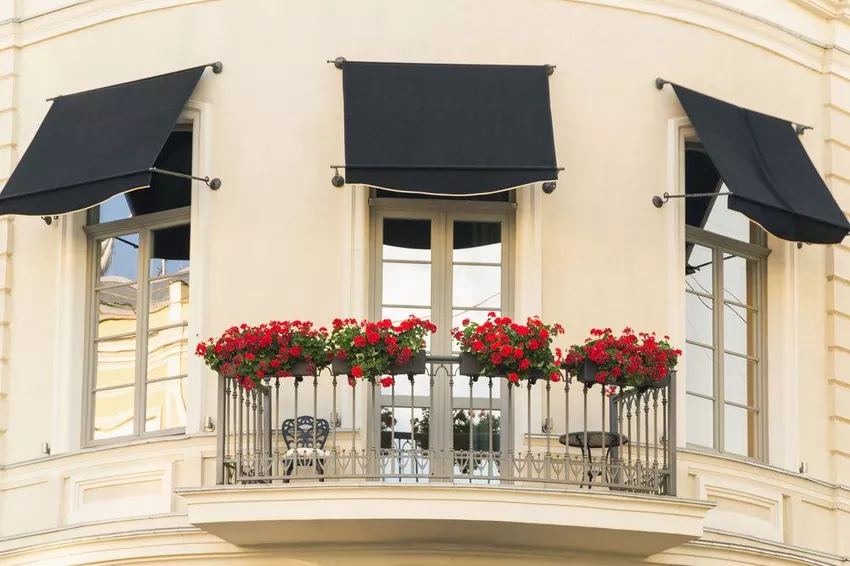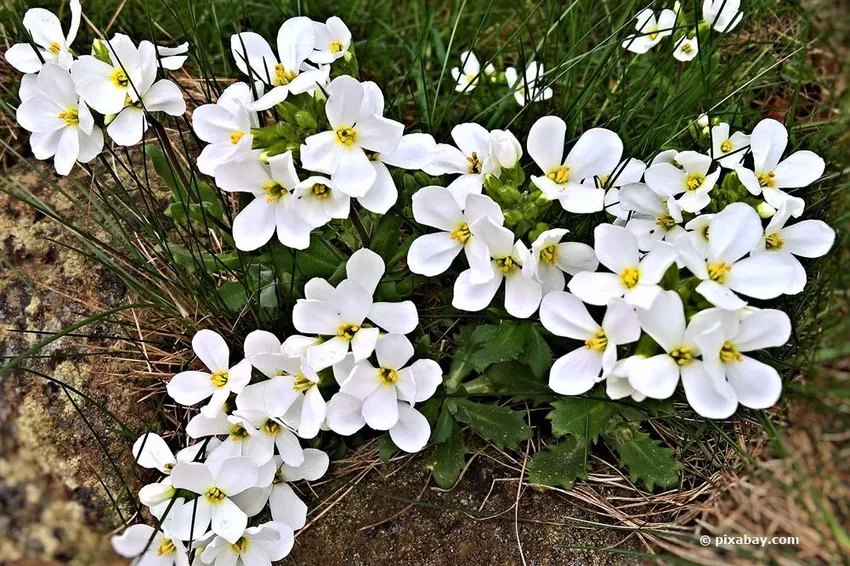
With balcony plants, everyone can create an oasis of well-being decorated with flowers. An important aspect when choosing balcony flowers is the right location. While a garden usually offers sunny to shady places, balcony owners are bound to the unchangeable lighting conditions. Most flowers need a sunny to shaded location. You can find out at Plantopedia which balcony flowers ensure lush blooms even in the shade.
Balcony plants for shade
If there is a lack of sun on the balcony, the selection of balcony plants is significantly smaller than for a place flooded with sunlight. Nevertheless, you don't have to do without splendidly thriving balcony flowers. Below you will find an extensive list of balcony flowers that love shady balconies and offer you countless design options.
Shady location - definition
Before you buy balcony plants, you should know when there are shady conditions or what that means.
shadow types
penumbra
Partial shade is used when locations receive between three and four hours of sun a day and shade occurs in the remaining hours. This is caused by the course of the sun, so obstacles such as walls and trees block sunlight.
As a rule, most semi-shade plants tolerate blazing midday sun for a short time. A location for semi-shade balcony plants is ideal when the morning sun hits them. The afternoon sun, especially in summer, can get too hot and cause burns.
light shadow
A light shade is given when sun and shade alternate continuously. This is usually a sunny spot that is shaded by the leaves of a tree, for example. With sparse foliage and/or branches, the wind ensures shady and sunny moments. Partial shade plants in particular thrive here.
 plant flower boxes
plant flower boxes
light shadow
A light shadow is a place that gets a lot of daylight but no direct sun. It differs from a classic shade by having more daylight, while typically shaded locations offer darker conditions overall. The light shade is a condition that moves between penumbra and full shade, without the sunlight hitting the balcony plants, but bright daylight is available through sunlight reflections.
full shade
In the full shade there is no sunlight and the daylight is quite dark. Sunlight reflections, such as in light shade or brief incidences of light through sparse foliage on trees, do not reach fully shaded locations. Full shade is predominantly found on balconies that face north. However, these occur less frequently, because architects usually pay attention to the fact that sunlight hits balconies when planning the building. Nevertheless, trees or buildings in front of it can also provide full shade on south-facing balconies. Balcony plants, which are suitable for maximum partial shade, often do not do well in full shade. There are a few exceptions, such as balcony plants that specifically prefer a fully shaded location.
Shade suitable balcony plants
Plants from B to D
Begonias (Begonia)
The begonia is available in the colors white, yellow, violet and pink. It blooms in all shade types from April to September. It grows up to 40 centimeters high, although growth can be a little stunted in full shade.
 Begonia x semperflorens cultorum, polar begonia
Begonia x semperflorens cultorum, polar begonia
Boxwood (Buxus)
Various types of boxwood are available. They are available for every location. Whether sunny, in partial shade or in light shade, the respective variety decides which is suitable for your shady balcony. Since growth is very slow, the hardy plants do not require excessive open space to thrive. You can spend the winter outside and add color to gray winter days.
 Boxwood needs the right location
Boxwood needs the right location
Chrysanthemums (Chrysanthemum)
Most chrysanthemum varieties prefer a semi-shady to shady spot. In full shade, the flowers may not be very abundant and growth may be slower. Otherwise, these flowers come in a wide variety of colors, which tastefully adorn balconies from early summer and, depending on the variety, until late autumn/winter.
 Chrysanthemums in full bloom
Chrysanthemums in full bloom
Sweet violet (Viola odorata)
With a strong scent, sweet violet fills the balcony environment in early spring and late summer when the plant is in full bloom. The sweet violet must not be too bright and sunny. For this reason it is the perfect balcony plant for light shade locations. If a tall tree with dense foliage is in front of a south-facing balcony, the sweet violet will reward you with strong growth and a wealth of flowers.
 Sweet Violet
Sweet Violet
Plants from F to G
Fire sage (Salvia splendens)
With a final size of up to 40 centimeters, the fire sage is ideal between green plants. Here its strong colors in fire red, purple or pink come into their own. As a balcony plant, it can be planted in partial shade as well as in bright or light shaded places. These flowers tolerate full shade less well. The fire sage is between 30 and 40 centimeters high and blooms from May to September.
 Fire sage, Salvia splendens
Fire sage, Salvia splendens
Fuchsias (Fuchsia)
Among the balcony plants, fuchsias are considered the classics, which are particularly popular on shady balconies. These balcony plants are available in white, pink/pink, red and blue-violet as well as dark purple. Especially as a hanging shade plant, fuchsias can fill boring shady balcony corners with color. In combination with other flowering plants, they provide lush flowers on small and large balconies. They bloom continuously from summer until late autumn.
 Fuchsia, fuchsia
Fuchsia, fuchsia
Busy Lizzie (Impatiens walleriana)
The diligent Lieschen is characterized by an immensely high number of flowers. The balsam plant, which usually grows to a height of 30 centimeters, inspires with a sea of flowers in white, pink, rose, orange or purple from May until autumn. Two-tone varieties are also available. They do well in a shady spot and give drab balconies a colourful, summery flair.
 Busy Lizzie, Impatiens walleriana
Busy Lizzie, Impatiens walleriana
Bellflower (Campanula)
The bellflower does well in semi-shade, light, bright and dark shady places. The hardy and perennial balcony plant flowers from May to September/October. You can choose from countless colors and sizes from 15 centimeters to two meters. She is very easy to care for. You only have to make sure that it is not too damp in the shade. This could possibly promote root rot.
 Campanula portenschlagiana, Dalmatian bellflower
Campanula portenschlagiana, Dalmatian bellflower
Plants from K to P
Nasturtium (Tropaelum majus)
The nasturtium is a real eye-catcher, which looks just as decorative between balcony flowers as between herbal plants. It blooms in shades of orange or red from June to October. Their body usually does not exceed a height of 30 centimeters. However, individual shoots can grow up to three meters long. In terms of light conditions, the annual nasturtium is quite undemanding. It thrives in sun as well as partial and full shade. The darker it is, the slower growth can take place. However, a loss of flowers is not to be expected.
 Nasturtium with blossom
Nasturtium with blossom
Climbing Hydrangea (Hydrangea Petiolaris)
From May, the climbing hydrangea begins to bloom in white. In partial or full shade, you can enjoy flowering until August. However, the perennial and hardy plant takes up a lot of space, as it can grow up to 15 meters high and five meters wide. A balcony should be correspondingly large or it should be pruned regularly to curb growth. The climbing hydrangea is ideal for bare and unsightly balcony side walls. With a tendril help, the climbing hydrangea can also act as a privacy screen.
 Climbing Hydrangea, Hydrangea petiolaris
Climbing Hydrangea, Hydrangea petiolaris
Globe primula (Primula denticulata)
The early bloomers include the globe primrose, which brings spring flair to balconies from the beginning/mid-March. It blooms in blue, violet, white or pink in any shady spot until the end of May/June. It is ideal for change boxes because it is hardy and, together with other early bloomers, heralds the balcony flower season early in the year.
 Globe Primrose, Primula denticulata
Globe Primrose, Primula denticulata
Pennywort (Lysimachia nummularia)
Pennywort is a good choice for partially shaded locations if you want to plant something very special in your balcony box with a yellow flowering ground cover and shoots protruding from the balcony box. Pennywort spreads out over the potting soil like a carpet. It blooms in May and attracts the bees.
 Pennywort, Lysimachia nummularia
Pennywort, Lysimachia nummularia
Primroses (Primula)
Primroses offer a generous variety of colors and, depending on the variety and weather conditions, bloom on your balcony as early as January. When choosing these balcony plants, it is important that you pay attention to the required location, because there are primroses that only thrive in a sunny place. Most species are hardy, bloom until April and reach a height of between 15 and 25 centimeters.
 Cup primrose, Primula obconica
Cup primrose, Primula obconica
Plants from S to V
snowflake flower (Sutera diffusus)
The snowflake flower, which likes it sunny and partially shaded, is perfect for a traffic light. It also tolerates a light shady spot. From June to September it flowers in white, purple, pink or light blue. It grows between 20 and 30 centimeters high, while drooping shoots grow up to 60 centimeters long. Hanging on the railing in the flower box, she decorates it from the outside with a magnificent sea of flowers.
 Snowflake Flower, Sutera diffusus
Snowflake Flower, Sutera diffusus
Spleenwort (Asplenium trichomanes)
The spleen fern is undemanding and easy to care for and can grow up to 30 centimeters tall. It is one of the hardy semi-evergreen plants. If it is to grow to its full size, a sunny, partially shaded location is required. It remains small in full shade, but is then perfect for balcony planting in the smallest of spaces.
 Spleenwort, Asplenium trichomanes
Spleenwort, Asplenium trichomanes
Bleeding heart (Lamprocapnos spectabilis)
From April to June, the Bleeding Heart flowers in shady and semi-shady locations on the balcony. The perennial ornamental and balcony flower is between 50 and 90 centimeters high and can be used as a shrub or as a standard plant in a bucket. Since it does not need sun, you can use it to optimally fill darker balcony corners. In the balcony box, it makes a stylish addition to other early bloomers such as primroses or forget-me-nots. For overwintering, simply cut off the shoots. Then it drives out again the following year.
 Bleeding heart, Lamprocapnos spectabilis
Bleeding heart, Lamprocapnos spectabilis
Vanilla flower (Heliotropium arborescens)
The vanilla flower offers a number of varieties that are suitable for a bright, semi-shady spot on your balcony. Their growth height is a maximum of 50 centimeters. It blooms in blue-purple or white from May to October. With an aromatic vanilla scent, it exudes a slightly oriental ambience on your balcony. For the winter season, however, it must be placed in a frost-free place.
 Vanilla flower, Heliotropium arborescens
Vanilla flower, Heliotropium arborescens
Forget-me-not (Myosotis sylvatica)
From March until well into June, the forget-me-not flowers in a colorful blue to a height of between 13 centimeters and 48 centimeters. The hardy plant feels just as comfortable in the sun as in the shade and partial shade. It is a robust plant that requires little maintenance and is one of the most popular flowers for balcony plants.
 Forget-me-not, Myosotis
Forget-me-not, Myosotis